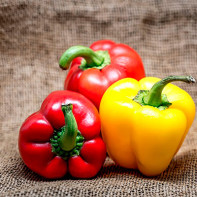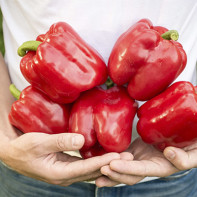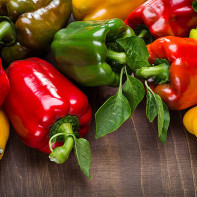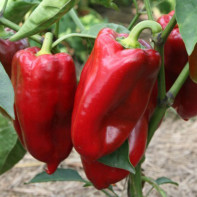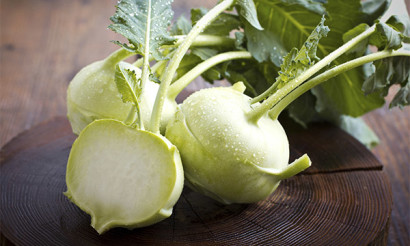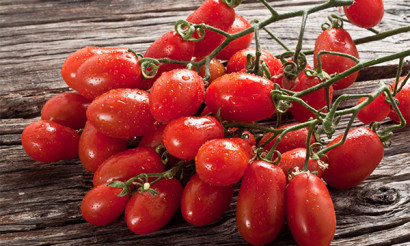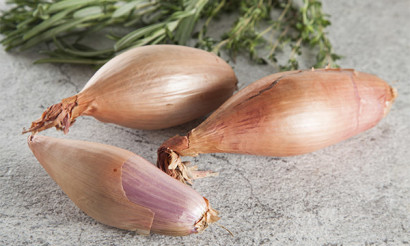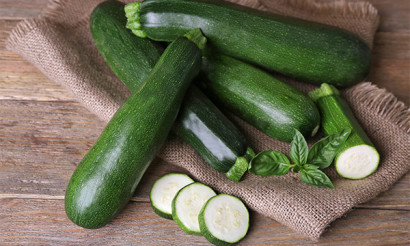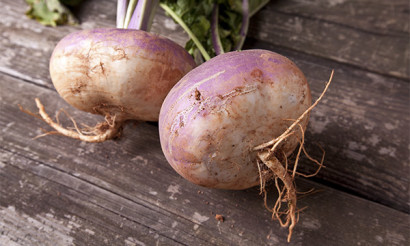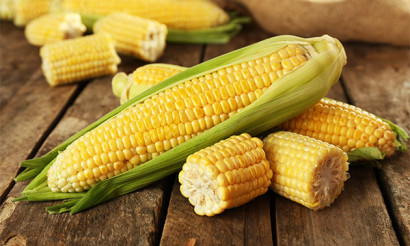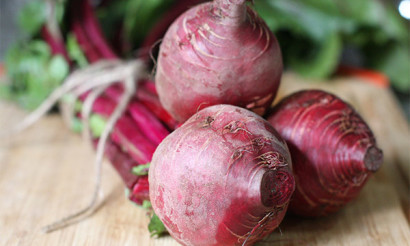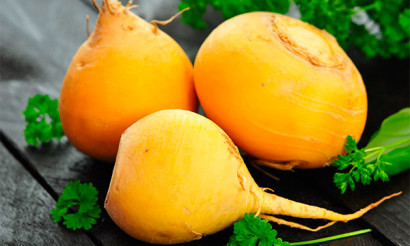Bell pepper: health benefits and harms
Many people like sweet pepper for its rich multi-faceted taste and the ability to cook many dishes with it: from salads and cold appetizers to stews and fragrant vegetable soups. It not only perfectly harmonizes with other products, but also benefits the body. There are also conditions in which you can not use bell pepper. We will talk about all its properties and features below.
- Why is pepper called Bulgarian
- What is the difference between paprika and bell pepper
- Composition and calorie content
- What is good for bell pepper
- General benefit
- For women
- For men
- During pregnancy
- When breastfeeding
- For kids
- Useful properties of pepper depending on color
- Red
- Yellow
- Green
- Which pepper is healthier: sweet or bitter
- The benefits of bell pepper for weight loss
- Bell pepper in medicine
- With diabetes
- With pancreatitis
- With gastritis
- For constipation
- With gout
- With hemorrhoids
- Bell pepper in cosmetology
- Masks for very dry and irritated skin
- Old age protection
- Hair root strengthening
- Harm and contraindications
- Bell Pepper Allergy: Symptoms
- How to choose and store bell pepper
- What can be cooked from bell pepper: recipes
- Stuffed peppers
- Greek salad
- Asparagus Beans Appetizer
- Is it possible to give bell pepper to animals
- Interesting facts about bell pepper
Why is pepper called Bulgarian
Solanaceous fruits appeared centuries ago on the American continents and were cultivated by the Indians. There is evidence that initially the peppers were bitter, burning and not used for food, but were used by shamans and doctors for the prevention and treatment of liver diseases, poisoning and anemia.

Over time, pepper grown in the beds became more juicy and edible, fruit seasoning was added to meat and fish to pickle the product and extend its shelf life, so the first prototype of paprika seasoning appeared.
After reaching Europe, peppers took root well in the southern climate and were grown in Mediterranean countries. Initially, the world knew only bitter peppers, but with the development of selection sweet varieties were also bred. According to some sources, today there are more than 100 varieties of this juicy fragrant vegetable.
Regarding the history of the name, there are several versions. One of them says that the varieties of sweet pepper that we know today were bred in Bulgaria, and in Soviet times this country was the main supplier of vegetables, in particular roasted peppers. One way or another, it is on the warm shores that the richest and richest crops are grown, and today delicious peppers can also be obtained in greenhouse conditions.
What is the difference between paprika and bell pepper
Paprika is a seasoning made from a mixture of red peppers: hot, fragrant and Bulgarian. It has a rich aroma and light pungency, so it is suitable for many dishes, including baby food, since it does not irritate the digestive tract like chili.
When buying dry paprika powder, today you can find seasoning with the addition of other aromatic herbs and ingredients, such as garlic and basil. They started making paprika in order to prolong the life of peppers: the fruits were dried and ground into powder, due to which the spice retained its rich aroma and taste, and subsequently passed it to various dishes all year round.
Sometimes called paprika means a red subspecies of sweet pepper, more fragrant than its counterparts of other colors.
Composition and calorie content
Peppers are a low-calorie product recommended in a healthy and dietary diet due to its valuable nutritional properties. 90% of them are composed of water, while rich in minerals, vitamin compounds and valuable dietary fiber. Protein in peppers is only 0.4 g, fat - 0.8 g, and these are very small indicators. Carbohydrates are about 6 g, and the energy value of bell pepper is 24–28 kcal per 100 g, depending on the variety.
The sweetest ones are yellow and orange varieties: they have more calories, the average content will be in red peppers, and green ones are an unsaturated variety that has the least sugar and other useful substances, it is valuable in dietary fiber and phytosterols.
Pepper contains:
- Calcium and phosphorus are necessary for strengthening bones and normal heart function.
- Potassium, involved in the regulation of pressure and water-salt balance in the body.
- Manganese needed to maintain bone health and blood composition.
- Sodium, necessary for the healthy chemical processes of the nervous and cardiovascular systems.
- Zinc and selenium, supporting hormonal health and strong immunity.
- Iron involved in the creation of red blood cells.
- Vitamin A, useful for vision and promoting tissue regeneration, relieving inflammation and rapid healing of injuries.
- B vitamins that ensure the health of the nervous system, protective and autonomic functions of the body.
- Vitamin C, an antioxidant that helps cope with viral infections.
- Vitamin PP, fighting the formation of cholesterol plaques in blood vessels.
- Vitamin K, providing normal blood coagulation.
Hot peppers also contain antimicrobials, painkillers, and toxins.
In different varieties, the combination of nutrients can be different, therefore, colored peppers are recommended to be combined in dishes not only to improve taste, but also with the goal of greater benefit for the body.
What is good for bell pepper
General benefit
A light and nutritious vegetable is necessary to saturate the body with vitamins. Of course, there is nothing irreplaceable in the product, but it perfectly diversifies the table and brings a rich portion of useful elements.

Bell peppers contain fairly tough fiber, which is useful not only for cleansing the intestines, but also for satisfying hunger after eating. The vegetable is easily digested, creating a feeling of satiety, so it is often included in the diet for weight loss.
Pepper helps maintain body strength and stay toned. A juicy fruit brings with it a sufficient amount of fluid, so the digestion process is comfortable. With various characteristics of the body, pepper can be useful.
For women
For example, it is useful for women to maintain a slim figure and fight body fat. Peppers disperse blood, triggering active digestion and speeding up metabolism.
Another useful property of peppers is improved skin condition. The constant use of this product will relieve rashes, peeling, traces of fatigue on the skin, restore elasticity and a healthy complexion, contribute to the elimination of toxins and slow down oxidative processes.
Pepper masks strengthen not only the skin, but also the hair, helping to combat fragility and restore the balance of life-giving moisture.
Pepper also strengthens the nervous system, helping to maintain balance and maintain high performance even in PMS and during menopause.
For men
For the stronger sex, pepper is useful in its ability to maintain the body in good shape - this is useful for strength training. In addition, it contains a sufficient supply of selenium and zinc, necessary to maintain male sexual health and the ability to have children.
Sweet pepper is often used in the fight against impotence to restore blood circulation and relieve inflammatory processes in the pelvic organs.
Pepper is used to protect against baldness: for this, a decoction of inedible parts of the plant is used.
During pregnancy
During pregnancy, bell peppers will be useful for maintaining normal digestion and regular stool. It will help to avoid constipation, bloating and other discomfort.
In addition, the vitamin-mineral composition of bell pepper will provide the fetus with the necessary elements for the formation of the nervous system and internal organs, maintain a normal level of hemoglobin and healthy maternal immunity.
Thanks to the use of peppers, endurance will increase and mood will normalize.This product is safe for inclusion in a healthy diet during pregnancy. It goes well with protein foods and other wholesome foods.
When breastfeeding
When breastfeeding, it is advisable to consume pepper in small portions and carefully monitor the well-being and reaction of the child, since the product sometimes causes allergies. Some pediatricians recommend returning the vegetable to the diet after 3 months of feeding. In this case, it is advisable to give preference to a thermally processed product, since potential allergens are destroyed in it, and fiber becomes softer.
The benefit of pepper during this period is to maintain a healthy composition of the mother’s blood and high quality milk, remove toxins from the body, rejuvenate, and quickly restore strength. In the event of a rash in the baby, consult a pediatrician.
For kids
Peppers are also good for children. It is introduced into the baby’s diet only after a year, first in the form of steamed mashed potatoes and only later in general. Fresh fruits can be given to a child after three years if intolerance is not found.
Hot peppers are given to children very carefully in minimal quantities so as not to irritate the intestinal mucosa and allow the digestive system to fully form and get stronger.
In a child’s diet, pepper is important for supplying the body with a vitamin complex, good digestion, strengthening bones, developing the cardiovascular system, maintaining normal nervous functions, vitality and activity, protecting and building strong immunity. Also, the vegetable provides prevention of constipation, support for good vision and the rapid healing of abrasions, scratches and other skin lesions, which is important in the life of little fidgets.
Useful properties of pepper depending on color
In general, the composition of peppers remains constant regardless of their shades, but some subspecies contain specific substances that are useful in various diseases.
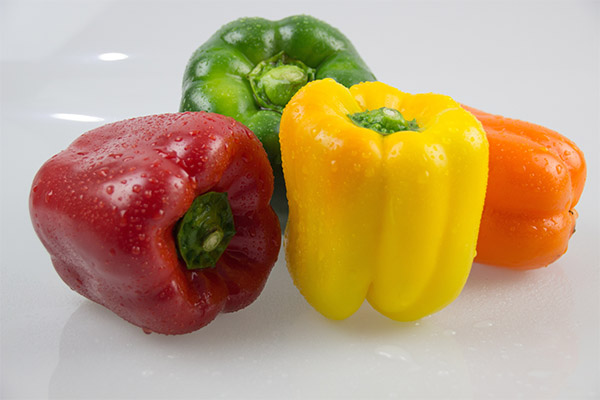
Red
Red pepper contains a maximum of vitamin C and helps the body remain resistant to viruses. It strengthens the walls of blood vessels, providing prevention of atherosclerosis, has an antioxidant effect. Red pepper has a positive effect on the digestive system, stimulating the production of gastric juice. Paprika helps control appetite, eliminates discomfort in the digestive tract, and helps to cleanse the blood and liver.
Yellow
Yellow pepper is rich in carotene, which is responsible for visual acuity and skin integrity. The use of yellow and orange peppers is useful in inflammatory processes for the speedy renewal and healing of the body.
Also, yellow peppers have more sugars - it saturates the body faster and helps on diets when you need to get rid of hunger.
This pepper contains more iron, necessary for blood formation, as well as potassium and phosphorus. The product will help maintain water balance and regulate the functioning of the excretory system. The use of pepper during fitness training helps stimulate metabolic processes and remove toxins, excess fluid and salts from the body.
Green
Green pepper has a low glycemic index and normalizes nervous activity. It contains phytosterols - substances that contribute to the removal of cholesterol from the blood and fat metabolism in the body.
Green pepper provides the prevention of atherosclerosis and promotes weight loss. This species is usually used fresh to preserve its beneficial properties.
Which pepper is healthier: sweet or bitter
It would not be entirely correct to compare sweet and hot pepper varieties with respect to their useful properties, since the substances that give bitterness to the fruits not only have a healing effect, but can also harm.
Hot peppers help cleanse the liver and have a choleretic effect, stimulate a quick metabolism, improve blood circulation, and support brain activity. However, they can not be consumed in large quantities.
Sweet pepper is safe for the body in larger portions. Its fiber allows you to remove toxins, and trace elements protect the skin from the negative effects of the sun, irritation, dryness, sagging and tired look. Sweet peppers are less likely to cause allergies and contain more iron.
It is recommended to combine different types of pepper in food: use hot varieties as seasoning, and sweet varieties as the main component in salads, stews, side dishes and soups.
The benefits of bell pepper for weight loss
On diets, it is important to consume a lot of dietary fiber for weight loss. This helps to cleanse the intestines of toxins, start healthy motility, and also feel satiety for longer without resorting to frequent snacks throughout the day. Sweet bell pepper helps well in this.
It can be used as the main component of a dish to reduce the use of starchy side dishes, such as porridge and potatoes. Nutritionists recommend combining peppers with legumes to enrich the diet with protein. In addition, it is desirable to supplement the product with animal food: lean meat, eggs, as well as nuts and vegetable oils.
The use of pepper while dieting prevents the depletion of the body, supplying the necessary vitamins for the full operation of all systems. Thanks to this, activity and good mood remain. The iron content ensures the normal composition of the blood, and phytosterols contribute to the removal of excess fat.
The use of hot peppers during diets warms up blood, speeds up metabolism and helps to burn extra pounds. But you need to do this carefully: in small proportions and strictly with other foods, so as not to harm the stomach.
Pepper helps maintain normal fluid circulation in the body, relieving swelling and promoting the "flushing" of all cells and systems. This is important on diets to rebuild the body to a new regimen.
Bell pepper in medicine
Since ancient times, physicians have resorted to the help of bell pepper in the treatment of anemia and liver diseases, as well as colds and even fungal ailments. Pepper is popular in folk medicine. Traditional doctors recommend consuming vegetables on diets for a number of diseases and at the same time observe certain necessary cooking conditions and norms.
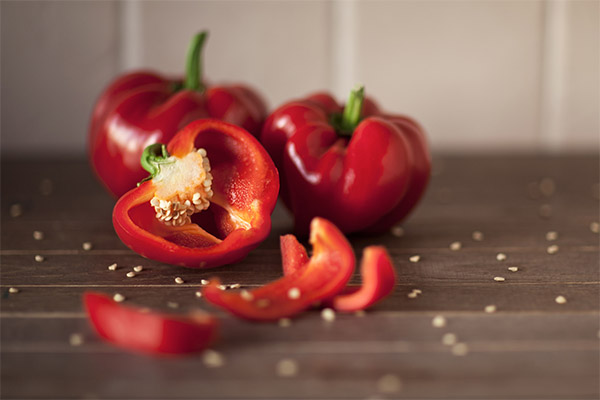
With diabetes
Due to the low glycemic index (15 units), the vegetable is safe in the diet of diabetics. It will help those who want to lose weight, because it creates a feeling of satiety. Such a vegetable is not digested too quickly - this allows you to forget for a few hours about snacks, and therefore, to avoid jumps in blood sugar.
You can choose any kind of pepper, but it is better to give preference to a red or green appearance, since they protect blood vessels from the formation of cholesterol plaques, which allows you to remove excess fats from the body, normalize blood pressure and improve well-being in diabetes.
Yellow varieties will help to cope with puffiness and improve the condition of the skin and eyes. For diabetics with complications of this type, orange and bright yellow peppers, as well as assorted ones, will be relevant.
With pancreatitis
Since bell pepper is a low-sugar and fat-free product, its use is acceptable for pancreatic inflammation. But for this pepper must necessarily be dietary - softened or even crushed in mashed potatoes. It is forbidden to use hot pepper, which can provoke complications of the disease. For more detailed recommendations, consult a doctor.
With gastritis
With inflammation of the gastric mucosa, it is not recommended to use coarse fibrous products, which include bell pepper. So that the vegetable does not harm the stomach, it must be thermally processed: bake, stew in cream, and steam. The use of bitter varieties that irritate the gastrointestinal mucosa is strictly prohibited. In small quantities and in the absence of allergies, sweet bell pepper can be useful to the body, the main thing is to be careful.
For constipation
Fibrous pulp of bell pepper contributes to the natural cleansing of the intestine and increases its patency. Such a tool will help in cases where there is a chair, but constipation occurs stably. For the best result, it is recommended to use the pulp of pepper in a softened form: steamed, stewed, without excess fat.
A diet with soft fiber helps to normalize the consistency of the stool, and also regulates the bowel movement. In cases of acute constipation, a preliminary cleansing of the intestines with enemas is required, and only then a diet is prescribed.
With gout
With gout, doctors recommend limiting the use of nightshade crops, including peppers, to avoid seizures and exacerbate the disease. This is due to the content of purines in pepper - substances that interfere with the normal excretion of urea. A healthy body can easily cope with these compounds, but a predisposition to the deposition of salts in the tissues makes you refuse such products.
In particular, hot peppers should be avoided, and if the product is really loved, you can use fresh or steamed yellow peppers, but in no case fry it in oil and do not smoke.
With hemorrhoids
With hemorrhoids, doctors advise reducing the consumption of bell pepper so as not to provoke an aggravation of the disease. Pepper should not be eaten with open bleeding, hematomas, including hemorrhoidal cones.
With cholecystitis
To cure gallbladder inflammation, rest is needed. Sweet pepper causes excessive formation of gastric juice and stimulates the secretion of bile, which strains the diseased organ. Therefore, in acute cholecystitis, bell peppers are not recommended for use.
Bell pepper in cosmetology
Homemade carotene masks are able to quickly rehabilitate even tired and dry skin. So, in a couple of minutes you can cook several "rescuers."

Masks for very dry and irritated skin
Fresh pepper gruel is mixed with sour cream and carrot juice in a ratio of 1: 1: 1, 0.5-1 tsp will leave on the face. They withstand such a mask for about 10 minutes, and do not use soap when rinsing (to remove sour cream, you can wipe the face with a tonic). The mask is repeated 1-2 times a week until the skin stops “eating” the useful mass.
Old age protection
To maintain skin elasticity and rejuvenation, puree from 1 red pepper is mixed with a spoon of honey and applied to the face for 20 minutes, then rinse off the mass with warm water. You must first make sure that there is no allergy to red pepper!
Hair root strengthening
To saturate the hair and improve its growth, the juice of bell pepper is mixed with an egg and applied to the hair for 15-20 minutes, after which it is washed off with shampoo. The mask will not only strengthen the hair, but also make it shiny and soft.
Harm and contraindications
Bell pepper often causes allergic reactions in people with sensitive skin. The product does not cause serious harm from a chemical point of view, but sometimes it provokes a rash, fever, and tearing.
In particular, the use of bright red or dark green varieties of pepper can lead to such a reaction - yellow and orange fruits are usually safe. Rejection is caused by pepper bones, so it is advisable to thoroughly clean them before eating a vegetable.
Pepper has a number of obvious contraindications:
- severe diseases of the liver or gall bladder;
- increased acidity;
- irritation and chronic diseases of the gastrointestinal tract;
- high blood pressure and heart rhythm disturbances;
- gout and other urinary acid excretion disorders;
- children's age up to 3, and even 5 years;
- menstruation, bleeding.
So that pepper does not cause flatulence and intestinal upset, it is necessary to use it in small portions, and in case of unpleasant symptoms, give preference to cooked peppers rather than fresh ones.
Bell Pepper Allergy: Symptoms
Bell pepper intolerance is most often expressed as a skin rash, fever, swollen lymph nodes, nasal congestion or tearing, itching in the intestines or on the skin, and unpleasant bloating. All these symptoms can manifest themselves with varying degrees of severity at the same time or separately.
Symptoms may be similar to colds or poisoning, and it is important to keep track of whether they appear after eating pepper. This is especially true for the health of young children who have not yet begun to produce some enzymes for the digestion of plant proteins and other complex compounds.
How to choose and store bell pepper
When choosing fresh pepper, pay attention to the cuttings: they should not be dry. On the surface of the peppers there should be no wrinkles indicating loss of moisture, as well as damage.
Sometimes mold starts near the tails - it is better not to buy such a product, since the fungus spreads toxins throughout the fetus. It is also advisable to avoid peppers with too dense skins - this may indicate fertilizing with chemicals. A good fresh vegetable exudes a characteristic spicy aroma.
Store bell pepper in a vegetable vase at a temperature of 3-5 degrees for 1-2 weeks. Also, the product can be frozen or dried and triturated, and then used as a seasoning.
What can be cooked from bell pepper: recipes
In addition to adding fresh pepper to salads, vegetable stews and first courses, it is often chosen as the main product. So, from sweet peppers you can cook lecho in tomato or steam garnish for fish. Here are some more recipes.
Stuffed peppers
A delicious second dish is liked by many due to its fullness. It is suitable for a daily menu even during fasting, and cooking does not take much time.
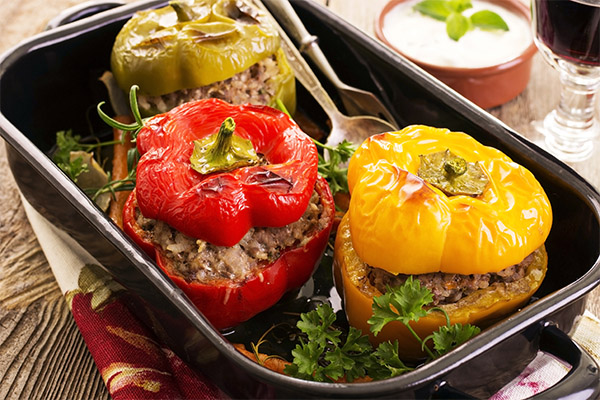
It is enough to boil rice, fry the carrots and onions in a pan, if the dish is meat, introduce the minced meat there. If the filling is purely vegetable, add green peas and corn. Mix the cooked fry with rice. Wash and clean the peppers from the seeds. Fill the base and simmer in a casserole under a lid with the addition of tomato paste until ready.
Greek salad
The classic recipe excludes the addition of mushrooms or onions. You will need these components:
- bell pepper red and yellow - 0.5 pcs.;
- tomato - 1 large;
- cucumber - 1-2 pcs.;
- lettuce leaves;
- feta cheese - 100 g;
- olives - 8 pcs.;
- cold pressed vegetable oil, salt, spices to taste.
Peppers are cut into half rings, and the remaining components are cut into large cubes, served chilled.
Asparagus Beans Appetizer
This recipe is convenient in that you can cook a dish from frozen foods:
- bell pepper (assorted) - 200 g;
- green beans - 200 g;
- leeks - 100 g;
- salt and spices to taste;
- vegetable oil.
Vegetables can be chopped in a convenient form and fry in oil. At first, everything is brought to a half-preparedness over medium heat, and then they languish under the lid for a few more minutes.A hearty dietary side dish is ready in a hurry.
Is it possible to give bell pepper to animals
Bell pepper is recommended to be introduced into the diet of domestic dogs and cats to enrich food with vitamins and fiber. Vegetables are given no more than 1-2 times a week in small quantities - depending on the characteristics of the breed, the exact information can be obtained from the veterinarian. Experts say that such top dressing can come in both fresh and processed form.
Interesting facts about bell pepper
- Pepper causes an endorphin release in the body, similar to a reaction to chocolate, so you can safely bet on a healthy vegetable on a diet to maintain your mood.
- On our shelves it is rarely possible to find the lilac subspecies, and in Europe and other countries it is already popular, characterized by a high content of anthocyanins. These substances strengthen blood vessels, regulate eye pressure, and fight bacteria and viral diseases.
- In Bulgaria, this type of pepper is called simply sweet.
- Modern sustainable varieties of bell pepper are juicy and bright aroma. They can be grown in any climatic environment.
- Vegetable pepper has nothing to do with spicy seasoning - these plants belong to different genera.
«Important: all information on the site is provided exclusively in fact-finding purposes. Before applying any recommendations, consult with a profile specialist. Neither the editors nor the authors are liable for any possible harm caused materials. "


